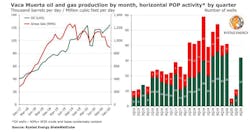Argentina’s Vaca Muerta tight oil deposit producing at record levels
Oil output from Argentina’s Vaca Muerta formation has pushed past pre-pandemic levels to reach a record high 124,000 b/d in December 2020, according to Rystad Energy. The ascent could continue to 145,000-150,000 b/d by end-2021 if current activity levels continue.
The previous oil production record was set in March 2020, when output reached 123,000 b/d.
Contrary to oil production, Vaca Muerta’s gas output continued to decline through the fourth quarter due to lower seasonal consumption. Gross gas production fell below 900 MMcfd in December for the first time since October 2018.
“While well activity in the gas zone of Vaca Muerta remained depressed in the final 3 months of last year, with literally zero gas wells put on production, oil POPs rebounded sharply in November and December, pushing the new oil well count to an average of about 11 wells per month,” said Artem Abramov, head of shale research at Rystad Energy.
YPF accounted for about 95% of Vaca Muerta shale’s oil production 4 years ago, with most volumes coming from Loma Campana, its joint venture area with Chevron. In the past 4 years, other producers such as Shell, Pan American, Vista, ExxonMobil, and PlusPetrol have increased activities in the play’s oil window to gradually account for a larger share of the play’s volumes.
As of December 2020, YPF is yet to return to its pre-COVID-19 Vaca Muerta oil production record, and the play’s recovery was therefore mainly driven by producers with aggressive 2020 capital programs. Vista produced 15,000 b/d of oil and Shell followed at 13,000 b/d in December, all-time highs from the basin for both operators.
TecPetrol and YPF—the two largest gas producers in Vaca Muerta—implemented considerable production curtailments in the fourth quarter, a practice that has become common for the play to cope with seasonal consumption lows. In addition to infrastructure challenges, uncertainty surrounding the future of subsidies for unconventional gas production from the play has also weighed on operations.
“While the gas window of Vaca Muerta offers ample potential for proven low-cost development, we remain conservative about the chances of the gas portion of the play to grow substantially in the medium term,” Abramov said.
Frac sand intensity continues to increase, while frac fluid intensity in the play is flattening. This occurs when operators adapt increased sand density completions after they are done with transitioning to slickwater, and was also seen in US unconventional basins several years ago.
Operators in Vaca Muerta are working to implement best completion practices of US unconventional plays. The average completion speed, measured in either lateral ft/day or frac sand pumped per day, has more than doubled since 2016.
Well productivity has improved. Contrary to major US unconventional basins where operators have largely reached an inflection point, Vaca Muerta’s oil development is only now entering manufacturing mode, though the downturn has also induced a certain degree of high grading. There had been a 6–7% improvement in most well productivity metrics for Vaca Muerta oil wells in 2019-2020, according to Rystad Energy.
While some cost efficiencies are yet to be realized, the play already competes with the best US tight oil basins in Texas and New Mexico from a well productivity perspective.
“The two-stream estimated ultimate recovery (EUR) range for recent Vaca Muerta completions is comparable to what we are seeing in the US Midland and Eagle Ford plays, while extremely low gas-to-oil ratios—even lower than the Bakken—help Vaca Muerta achieve superior oil stream EURs on a per lateral foot basis.
“This emphasizes the fact that Vaca Muerta’s oil window producers have almost no exposure to gas and NGL economics, whereas producers in the US face a particularly high impact on their overall economics during downturns in the gas and NGL markets. As a result, we argue that the PV10 wellhead breakeven oil prices in Vaca Muerta’s oil window are already at the same level as the best US tight oil plays,” said Abramov.


